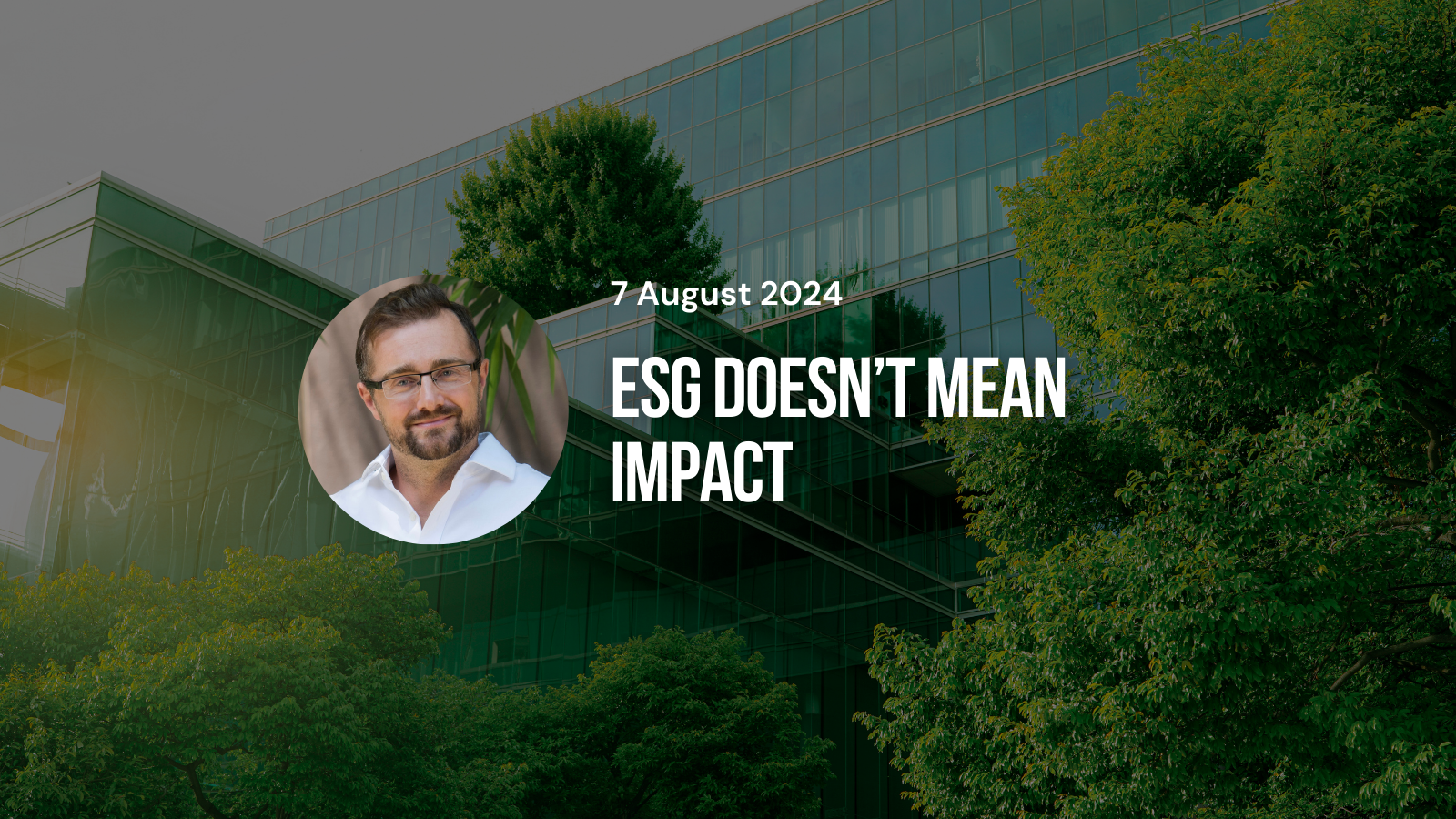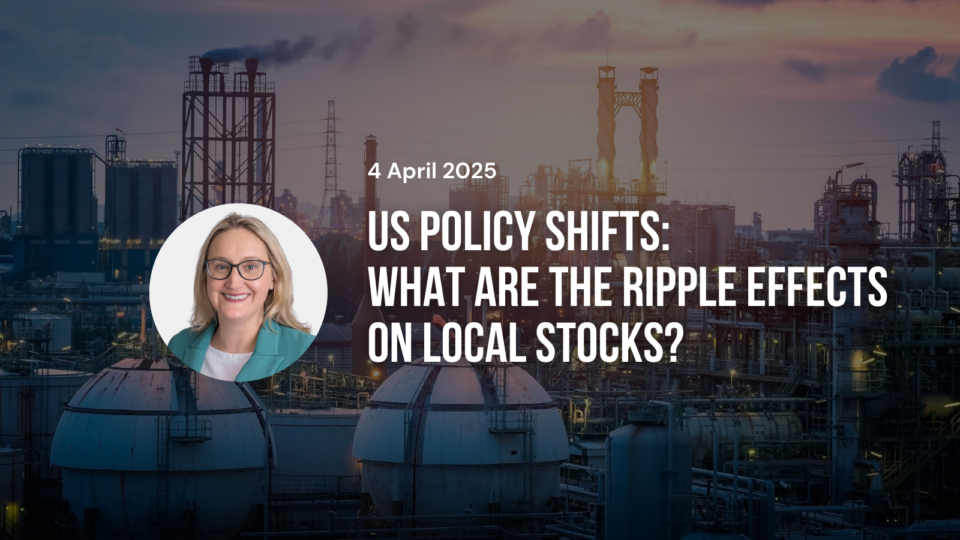

By Simon Turner, Head of Content, InvestmentMarkets
7 August, 2024
As the transition towards a low carbon, more sustainable world accelerates, many investors have assumed that ESG is connected with the impact needed to address the world’s environmental and social challenges for the simple reason they hear the term so often.
But there’s more to it than that.
So what is ESG? And what isn’t it?
The curious origins of the term ‘ESG’
The first group to coin the phrase ‘ESG’ was the United Nations Environment Programme Initiative in their Freshfields Report in October 2005.
According to Paul Clements-Hunt, who was leading this work at the time, they’d initially decided to run with ‘GES’ since they believed Governance was most the important area for investors, followed by Environmental, and then Social.
It was decided that ‘GES’ was ‘not so catchy, not so sexy’. Let’s not ask why Mr Hunt was so focused on the sexiness of the acronym, but it remained integral to the discussion. They decided the E was ‘sexy upfront’, and the S should go in the middle as they thought it was most likely to be ‘flicked off the end by Milton Friedman-esque lobbyists’.
‘ESG’ was subsequently concertised into the sustainable investment world in the ECOSOC Chamber at UNHQ.
Mr Clement-Hunts was surprised by how well received ‘ESG’ has been: ‘We never could have imagined where it would end up.’
No one could have imagined that three simple letters placed in the sexiest possible order would help enable the scaling of the sustainable investment movement.
But they have. ESG integration is now a foundational strategy for most forms of sustainable investment.
What ESG means for investors
ESG is essentially a world of corporate performance data covering a vast array of environmental, social, and governance issues.
It covers environmental factors such as carbon emissions and the amount of water used, social factors such as gender and race diversity, and governance factors such as corporate risk management practices.
These days, ESG integration is regarded as one of the basic building blocks of a sustainable investment strategy.
The question may be running through your mind: weren’t high priority ESG issues being monitored and analysed by corporate management and financial markets anyway?
The answer is yes and no.
Yes, many of the better management teams have always actively managed ESG issues as it makes good business sense and reduces corporate risk.
For example, reducing a company’s carbon emissions not only helps mitigate against climate change, it also reduces a company’s cost base and its risk of climate change-related litigation in the future.
But the answer is also no, because many companies have chosen not to focus on ESG performance or disclosure despite the overwhelming arguments in favour of doing so.
In recent years, financial markets have increasingly demanded high quality ESG information as it helps investors mitigate against known risks.
So for most investors, ESG is the process of integrating environmental, social, and governance data into investment processes with a view to de-risking their portfolios and thus improving investment performance.
What ESG isn’t
Equally important is what ESG isn’t…
ESG isn’t an exclusion strategy.
Exclusion strategies rule out certain types of investments based upon poor performance in areas such as environmental performance, ethical considerations, or the industry they are operating in.
For example, ethical investors rely heavily on exclusion strategies such as avoiding tobacco, weapons, and gambling companies to define their investment universe.
This is an important point for investors to understand: ESG integration by itself won’t ensure a portfolio is invested in companies which are either avoiding doing bad, or actively doing good.
Secondly, ESG isn’t an inclusion strategy.
Integrating ESG factors into an investment process doesn’t automatically lead to companies with only excellent ESG credentials making it into a portfolio.
It just means ESG factors are actively considered within the investment process.
In other words, companies with mediocre ESG performance may still be included in an ESG integrated portfolio if their traditional (non-ESG) performance is excellent.
Thirdly, ESG integration doesn’t take business purpose into account.
This is an important point which many investors aren’t aware of.
For example, a renewables company’s purpose may be to help accelerate the transition to a low carbon world, while a tobacco company’s purpose may be to enable their customers to enjoy high quality tobacco products.
However, these two companies may have same ESG score as one another because business purpose is ignored by ESG analysis.
And finally, ESG integration doesn’t necessarily translate into impact.
By way of background, impact is defined as intentional and measureable social and environmental returns which are not just valued in financial terms.
For example, a technology company may help to alleviate poverty in developing countries by donating internet access to people who can’t afford it. The social impact of this strategy may be extraordinarily high, but that same company may not perform well on ESG factors because its governance may be weak.
In other words, there’s no direct connection between strong ESG performance and on-the-ground impacts.
That’s empowering information for investors who want to generate impact with their investments.
What’s an investor to do to bridge the ESG gaps?
There’s clearly a gap between ESG integration and investing to make the world a better place.
So what’s an impact-driven investor to do?
Investors should arguably be working with professional fund managers who have expertise in constructing sustainable investment portfolios which leverage the risk-reducing benefits of ESG integration combined with impact-generating strategies that address what ESG isn’t.
Here are some examples of strategies which align with ESG integration whilst honing in on impact-focused investment opportunities:
- Exclusion screening – ensures a portfolio is not exposed to companies which are causing harm.
- Inclusion screening – ensures a portfolio is exposed to companies which are benefiting from the opportunities created by being sustainable. For example, this type of screening helps investors focus on companies benefiting from climate change, biodiversity loss, and global water scarcity.
- Ethics/norms-based screening – ensures a portfolio is not exposed to companies operating below a minimum ethical standard.
- Corporate engagement – by communicating their impact and sustainability expectations to management teams, professional investors are able to signal the importance of these issues, which helps drive the required management action.
- Impact investing – with more investors demanding their investments create measurable and intentional impacts, impact investing is a strategy which is particularly well positioned to benefit from the sustainability boom.
Position yourself to benefit from a more sustainable world
Whilst ESG integration by itself doesn’t mean impact is being created, there are a number of strategies that can be combined to create sustainable investment portfolios positioned to benefit from the low carbon transition and other compelling sustainability themes. As such, investors have the opportunity to do good with their money whilst generating solid financial returns.
If that aligns with your investment goals, it may be time to position your portfolio in best-in-class sustainable funds which are positioned to make a difference for people and planet.
Originally published on InvestmentMarkets





